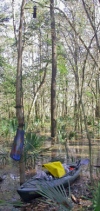               |
 |
||||||
|
The 2006 Choctawhatchee Ivorybill Video The Discovery |
|||||||
| A Follow-up Study Geoff, Tyler, and Brian decided to conduct a winter search to try to gather better evidence for the presence of ivorybills. They asked Dr. Dan Mennill to join the search and conduct sound monitoring in the area. Dan had just completed a postdoc in Geoff’s ornithology lab and was starting as an assistant professor at the University of Windsor in Ontario. Dan devised a means to remotely record sounds, and he constructed seven listening stations that were deployed in the area of the ivorybill sightings. Dan also recruited a grad student, Kyle Swiston, to maintain these stations in the field including swapping batteries and memory cards daily. From mid-December through the end of April, Brian and Kyle lived in a remote camp in the swamp forest along the Choctawhatchee River. Geoff came to the area two weekends per month to receive audio recording files and to search for ivorybills. Tyler was on the site for one month from mid-December to mid-January and for ten days in March. Dan was in charge of detailed analysis of the thousands of hours of sounds being recorded. Kyle was occupied all day most days running listening stations. About 60% percent of hours spent searching for ivorybills on the study site were conducted by Brian alone. |
|||||||
| Full Disclosure of Evidence In the spirit of openness and to allow everyone interested in Ivory-billed Woodpeckers to fully review the evidence for him or herself, on this web page and on Dan Mennill’s web page we present essentially all of the evidence we have gathered -- photographs of numerous cavities, photos of trees with scaled bark, all of the write-ups of the sight recordings, and sound clips of the putative kent calls and double knocks that we recorded. View the materials. Enjoy them, criticize them, defend them, and debate them, but please do not reproduce them or publish any analyses based on them without our written consent. The data are part of an active research program. Two graduate students are currently using these materials as part of the their Master’s theses. The only thing we are holding back for now is the exact location of our study site and that is for the good of the birds. |
|||||||
| The Evidence Through this web page you can explore the five independent lines of evidence we collected that ivory-billed woodpeckers persist in the forests of the Florida Panhandle. 1.
Sightings - Click here
to learn about the direct
encounters we had with birds that showed field marks of ivory-billed
woodpeckers.
2. Sound detections - Click here to learn about acoustic encounters with sounds that match historical descriptions of ivory-billed woodpeckers. 3. Recordings - Click here to learn about our audio recordings of putative kents and double knocks 4. Cavities - Click here to learn about the large cavities we measured. 5. Feeding sign - Click here to learn about our measurements of feeding sign. In addition, you can take a pictorial tour of the choctawhatchee river. The evidence that we present for the persistence of ivorybills in this forest was collected in a small search area approximately one mile wide and two miles long (two square miles or 500 hectares). Mature swamp forest covers approximately 60 square miles in the Choctawhatchee River Basin, so we were working in only a tiny portion of available habitat. We believe that our study area was smaller than the home range of a single ivorybill pair. A detailed account of our study is published in Hill et al. 2006, published in the online journal Avian Conservation and Ecology. |
 |
||||||
| Background Information This web page assumes that the reader is familiar with the appearance and vocalizations of Ivory-billed Woodpeckers, the history of the demise of the ivorybill, and recent efforts to find remnant populations. For such background information, please see the ivorybill pages on the Cornell Lab of Ornithology Ivory-billed Woodpecker Website. |
|||||||
| Notable Aspects of our Search • Sixty percent of total search hours were logged by one individual, Brian Rolek. • Brian has 23 sound detections and 10 sightings. • Through July 2006, nine of fourteen visitors who spent more than 48 hours at the site detected Ivory-billed Woodpeckers. • Tyler Hicks recorded the best sight records by a skilled birder since the Singer Tract was cut. • This is the only area with multiple and regular sight and sound detections over a one-year period since the Singer Tract was cut in the 1940's. • From January to April 2006 we had repeated corroboration of ivorybill sounds detections between human observers and automated recorders. Not Proof Although members of our search group are convinced that Ivory-billed Woodpeckers persist in the swamp forests along the Choctawhatchee River, we readily concede that the evidence we have amassed to date falls short of definitive. Definitive evidence will come in the form of a clear, indisputable film, digital image, or video image of an Ivory-billed Woodpecker or perhaps from a fresh feather or DNA sample. No such indisputable evidence has been gathered since photographic images of Ivory-billed Woodpeckers were made in the Singer Tract of Louisiana in the 1930s. While we do not present our evidence as proof, we feel that the evidence that we have amassed is compelling and warrants a substantial follow-up effort. |
|||||||
| All information on this
website is
copyright Geoffrey Hill and Daniel Mennill. No information on this page may be used without explicit permission (ghillATacesagDOTauburnDOTedu or dmennillATuwindsorDOTca). |
|||||||
 |
 |
 |
 |
 |
 |
 |
 |